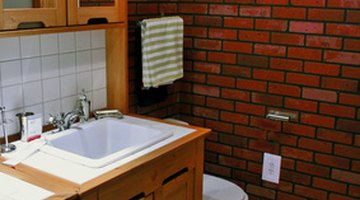How to Put Shelves in Cabinets
Maybe you inherited an old cabinet that has no shelves, or maybe you have a cabinet with shelves but you want to add more.

Either way, your home, garage, kitchen or shed will look much more tidy if you maximize the storage space inside those cabinets, especially if your rooms are cluttered with things like crafts, tools, paint cans or canning supplies. Adding shelves is the perfect way to economize the space you already have in your cabinets.
Things You Will Need
- Tape measure
- Pencil
- Straight edge
- 1- by 2-inch lumber
- 1-inch wood screws
- Screwdriver
- ½-inch plywood or particle board
- Saw
-
Measure from the inside bottom of the cabinet to the inside top of the cabinet. Divide that by the number of shelves you want. (For example, 48 inches high divided by four shelves equals 12 inches. Note that “four shelves” includes the base of the cabinet, so only three new shelves will actually be added.)
-
Using the measurement you obtained, mark the height above the inside bottom of the cabinet in all four corners. Continue marking multiples of that height above the bottom of the cabinet in all four corners. (For example, 12 inches, 24 inches and 36 inches.)
-
Cut 1- by 2-inch lumber to fit all lines on the left, right and back walls. Hold these wood braces flat against the walls of the cabinet so that the top edge of the lumber follows the lines. Drive 1-inch wood screws through the wood braces and into the cabinet walls. Insert one screw every 6 to 8 inches. If the cabinet walls are too thin to hold the screws, then drive the screws from the outside of the cabinet through the cabinet walls and into the wood braces.
-
Draw a level line along the left, right and back walls between each mark, using a straight edge. Note that this line marks the top of the shelf support; the actual shelf will be ½ inch higher because of the thickness of the plywood.
-
Measure the size of each shelf and cut plywood or particle board to fit. Slide each shelf into position and fasten with screws, driven from the top down into the wooden braces.
Tip
The plywood shelves may be too tight to slide into the cabinet after you have fastened the wooden braces into position. If this is going to be a problem, first insert the shelf and temporarily “hang” it with four nails or screws at the very top of the cabinet. Attach the wooden braces then remove the nails or screws and lower the shelf into position. Repeat with as many shelves as necessary. Alternately you may use ¼-inch shelf supports to hold the shelves in position. These supports are pressed into ¼-inch drilled holes in the side of the cabinet, and they allow you to easily move the shelves up and down if you drill more holes. Shelves that are wider than 2 feet may sag. If so, you may consider running a 1- by 2-inch piece of lumber across the bottom of the front lip of the shelf.
The Drip Cap
- Maybe you inherited an old cabinet that has no shelves, or maybe you have a cabinet with shelves but you want to add more.
- Either way, your home, garage, kitchen or shed will look much more tidy if you maximize the storage space inside those cabinets, especially if your rooms are cluttered with things like crafts, tools, paint cans or canning supplies.
- For example, 48 inches high divided by four shelves equals 12 inches.
- Hold these wood braces flat against the walls of the cabinet so that the top edge of the lumber follows the lines.
References
Writer Bio
James Werning has authored books and articles on various websites. His scripts have aired for more than 15 years on radio stations across North America. He is a small business owner and a world traveler with a master's degree in communications from the University of Edinburgh, Scotland.
Photo Credits
- bathroom image by nutech21 from Fotolia.com
- bathroom image by nutech21 from Fotolia.com
More Articles



